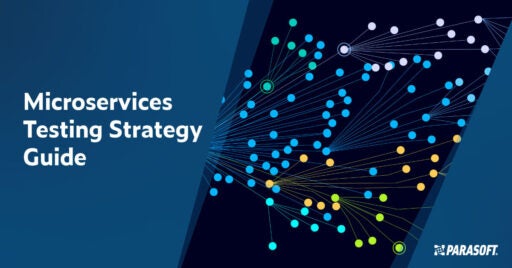Join Us on Apr 30: Unveiling Parasoft C/C++test CT for Continuous Testing & Compliance Excellence | Register Now
Jump to Section
Service Virtualization Tools
Are you on a search for the benefits of service virtualization tools and how to choose the right one for your dev and test teams? Read on to learn about the capabilities to include in your checklist and the top SV tools.
Jump to Section
Jump to Section
What Are Service Virtualization Tools?
Service virtualization tools provide teams with the ability to test an entire system even when some of its components might still be in development. Let’s explore the many attributes of service virtualization (SV) and compare the best tools that the industry offers.
Why Is Service Virtualization Important
Service virtualization is a method that development teams use to simulate the behavior of an application’s components. These components can be APIs, databases, networks, devices, and more.
Development teams use service virtualization because some components of the project might not be available for testing purposes when needed. Here are some reasons why components might not be ready.
- Developers are still building them.
- Problematic to set up or access.
- Hard to configure or provision in a testing environment.
- Third parties may own the components or charge a fee to access them.
- Only available for testing purposes at times that are inconvenient or in a limited capacity.
- Different teams may need them at the same time, each with various data setups and other necessities.
- Testers may find they’re restricted or expensive to use for performance and load testing.
By simulating downstream dependencies, development teams can get past obstacles such as these, with the teams swapping actual functionality for simulated responses and behavior. When used properly, service virtualization compels the system to behave exactly like it would if the component was complete and available.
Service virtualization acts like a flight simulator for applications. Testers test for deficiencies during development helping teams address potential problems so the plane doesn’t crash.
Benefits of Service Virtualization
Using SV saves money, time, frustration, and headache. Development doesn’t halt while team members wait for finished components from other areas. This is because service virtualization provides teams with ubiquitous access to precisely emulated test environments. Thus, teams avoid any “us vs. them” conflicts. Other benefits include improved testing accuracy and quicker time to market.
Service Virtualization Tools & What They Do
In addition to simulating the real behavior of the system’s components, SV tools can also duplicate nonfunctional parts of the system such as slow response times and connections.
SV tools can incorporate complex request matches, which allows the test to provide different responses for various request types. Some virtual services give a group of stubbed responses for the request criteria that testers provide, and then send all other requests to an operating backend system. Others simulate the behavior of the system when the SV constructs parts of the response based on request attributes and data.
Here are more helpful features:
- SV deploys a digital twin of your test environment to use as a sandbox for partner development or as a virtual endpoint for internal testing.
- Developers capture traffic using an SV platform to create virtual assets, as opposed to building the interactive pattern from scratch.
- SV supports various protocols, like HTTP, MQ, TCP, and many more.
- SV tools often feature user interfaces that allow non-developers to use the tools without having to understand the project’s details.
Steps Before Choosing a Service Virtualization Tool
Before teams start investing time, money, and effort into SV, doing some research and prep is advantageous.
- Make an appropriate analysis of test cases.
- Identify test data.
- Determine target load, where appropriate.
To realize the full value of service virtualization, it’s important to ensure that the tool meets and supports your team’s testing needs. Otherwise, it will become too complex and too expensive to maintain.
9 Capabilities That Make SV Tools Easy to Use
Here are nine capabilities to consider in a tool that might make service virtualization easier for your team to use.
1 – Scriptless Functionalities
Dev teams should be able to build virtual services without having to write any code. Instead, a visual tooling system is ideal. Usually, the person who needs a virtual service is a tester, who has less firsthand technical details about how the services were implemented.
2 – Rapid Virtual Service Creation Prior to Real Service Availability
Leveraging virtual services as prototypes before the real service is available is highly advantageous. With this feature, teams can create interfaces for dependent components of the application before they’re ready.
3 – Intelligent Response Correlation
This means that the service virtualization tool can respond differently based on the requests that come in. Different types of response correlation to consider include:
- Deployment protocol
- Message correlation
- Data source correlation
4 – Data-Driven Responses
Data-driven responses give teams the flexibility to create logic in an abstracted way. They can connect virtual services to data sources like Excel, CSV, tabular, hierarchical, and live databases for real-time data lookups.
5 – Ability to Reuse Services
Dev teams can work together to define core, common, or shared services, and then reuse those templates and logic in other virtual services multiple times.
6 – A Custom Extensibility Framework
Having the ability to use scripts but not be limited to a single language is helpful if you need to write code to accomplish tasks like generating a proprietary token or unique identifier.
7 – Support for Authentication & Security
With this type of support, your team can validate incoming transport layer security, such as SSL certificates, and interact with the live services during recording, which could be governed by authentication mechanisms like OAuth, Basic Auth, Digest, Kerberos, NTLM, and more.
8 – Configurable Performance Environments
Enabling performance testing enables teams to do earlier stage performance testing and reduces exclusive reliance on full testing environments. Teams can laser-focus on specific component SLAs by using virtual services to emulate out of scope dependencies. They can create performance environments by surrounding the application with virtual services.
9 – Support for Clustering & Scaling
As your performance team adopts service virtualization and general usage increases, you’ll need a tool that enables scaling, which can manifest in two forms: high throughput and fault tolerance. To support scaling, you’ll want a tool that can be clustered behind a load balancer so that you can distribute the load given to your virtualization infrastructure appropriately. You’ll also want a tool that can maintain asset parity as you modify different virtual services on individual nodes.
More SV Tool Capabilities to Consider
Capabilities associated with optimizing workflows, automation, support for management and maintenance, and supported technologies are important to consider in your search for the best service virtualization tool. Learn more here.
Best Service Virtualization Tools
We compare the features, benefits, and capabilities of the top service virtualization commercial tools.
| Tool | Key Features | Benefits | Disadvantages | Pricing |
|---|---|---|---|---|
| Parasoft Virtualize | Create complex virtual assets without scripting for over 120 message types. | Integration with Parasoft SOAtest (API testing) & Selenic (UI testing) as well as industry CI & IDE tools. | Fully integrated solution requires additional setup. | Contact Parasoft to request a quote. parasoft.com/contact/ |
| Web-based environment manager facilitates easy test configurations. | Modular approach to virtual services design enables easier maintenance. | Published pricing unavailable | ||
| Stateful virtualization enables complex stateful scenarios. | Easy scriptless virtual asset creation, even for the complex stuff like CRUD. | No SaaS offering | Download free version to get started. software.parasoft.com/virtualize/community-edition/ | |
| Virtual test data modeling and generation includes masking for sensitive data. | Extensive support for different technologies and protocols. | |||
| Collect and expose utilization reports and hit statistics. | In-depth world-class product support. | |||
| WireMock (UP9) | Autogenerate Kubernetes-ready mocks and codified test cases. | Transparent pricing | No low code. Requires scripting. | up9.com/pricing/ |
| Mocking integrated with UP9 API monitoring, testing, security, and observability. | Easy to download and test. | Limited functionality and protocol support. | ||
| Simulates HTTP-based APIs. | Open source | Few integration choices. | ||
| Easy to use for simple use cases. | No .NET support. | |||
| No team support or professional services. | ||||
| Traffic Parrot | Pre-defined API mocks | Ease of deployment | API mocks are limited in scope and complexity. | Affordable licensing model and cost plan for entry-level needs. trafficparrot.com/buy.html |
| Support for ephemeral containers, infrastructure-as-code, CI/CD, and Kubernetes. | Decentralized with web user interface. Cloud or VM. No on-premises option. | User management. If you deploy Traffic Parrot in a shared environment then whoever has the URL to the Traffic Parrot WebUI can access it without restrictions. | ||
| Supports major protocols and runs on OpenShift. | Built on open-source WireMock. | It does not allow for customizing more complex workflows. Instead, you write custom plugins/extensions yourself in Java. | ||
| Integrates with popular CI environments and other dev/test tools. | Does mocking as code. Docker and Jenkins integrations. | No "free" editions available. | ||
| SmartBear ReadyAPI Virtualization (ServiceVPro) | Formerly ServiceVPro, now integrated with SoapUI Pro and LoadUI Pro for API testing and mocking. | Easily integrates with the ReadyAPI suite and a large ecosystem of other SmartBear tools. | Poor reporting capabilities. | A la carte pricing makes it easy to pick and choose what product you want. |
| Run virtual services from the browser, cloud, or local client, on a remote machine or images. | Huge community and open-source tools. | Code generation isn't always smooth. | Free trial: smartbear.com/product/ready-api/api-virtualization/free-trial/ Pricing: smartbear.com/product/ready-api/pricing/ | |
| Import OAS, WSDL, or other API definitions or record live API or UI traffic to get started. | Supports popular messaging protocols (HTTP, REST, SOAP, JMS, and JDBC). | Limited protocol support. | Pricing available for Virtualization module online. Submit a request for a bundle quote. | |
| Analyze virtual service traffic and performance from a web UI. | Does not require deep technical knowledge or coding experience to get started. | Unable to handle heavy loads. | ||
| Configure parameters for multiple scenarios including capacity, bandwidth, and errors. | Outdated user interface | |||
| Micro Focus (HP) | Quickly create realistic simulations of APIs and virtual services. | Extensive support for different technologies and protocolsâ. | Limited support for modern tools such as Kubernetes. | Complicated pricing with high up-front cost. |
| Service virtualization features are integrated with LoadRunner and UFT (Unified Functional Testing) suite. | Simple to use but requires using scripting language (Visual Basic). | Not low-code, requires a lot of scripting. | Flexible license and deployment model. | |
| Large-scale load testing for realistic performance simulation scenarios without impacting production or third-party systems. | Data-oriented simulations. | Solution includes multiple offerings obtained through acquisitions from different vendors. | Contact: microfocus.com/en-us/products/uft-one/contact Free trial available: microfocus.com/en-us/products/uft-one/free-trial | |
| Shared repositories and shared libraries of reusable simulation assets. | Web-based interface | Limited formats supported for reporting. | ||
| Uses Excel for larger services instead of SQL-based implementation. | ||||
| Postman | Focused primarily on API testing with some support for API mocking. | Lightweight tool with small footprint and simple UI | Only has light static mocking tools. Does not do true service virtualization. | Multiple pricing plans. Billing can be annual or monthly for a premium. postman.com/pricing/ |
| Collaboration through workspaces to organize API development. | Built into API testing platform for mocking, security, and governance. | Very limited protocol support | ||
| Native Git support | Cloud options | More complex scenarios require extensive scripting. | ||
| Broadcom | Monitors traffic between the dependent and target systems to automate the creation of and updating of virtual services. | Service and application simulations that accurately model system behavior. | Complex pricing model with hidden costs. | Contact a Broadcom partner or distributor for a quote. broadcom.com/how-to-buy/partner-distributor-lookup |
| SV Java API Client enables developers to access SV functionalities and virtual services in Java code. | Scripting is useful for Dev teams. | Requires scripting for most services. | ||
| Smart self-healing capability automatically simulates responses. | Run tests across the full stack to validate APIs at every layer of a complex, multi-tiered application. | Limited support via partners. | Free Community Edition available upon request. | |
| Includes built-in capabilities for automated functional, UI, mobile, and performance testing. | Mainframe and multi-protocol support. | Hard-to-use thick client. | ||
| Integration with development and test tools. | Parallel development and testing. | Expensive and resource intensive. |




